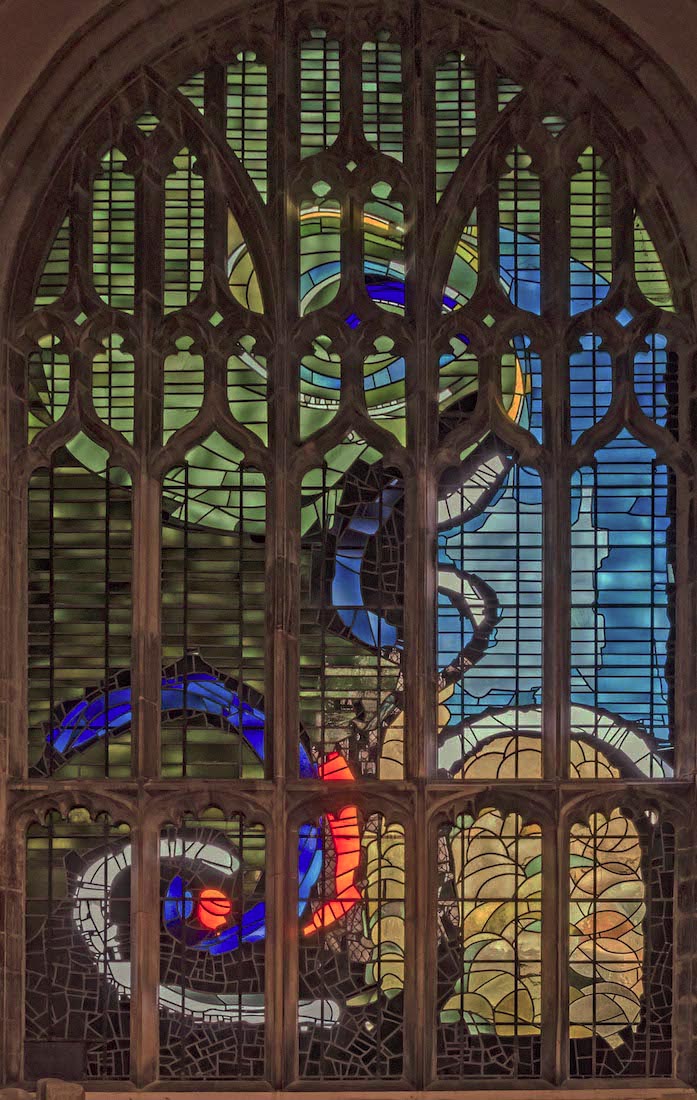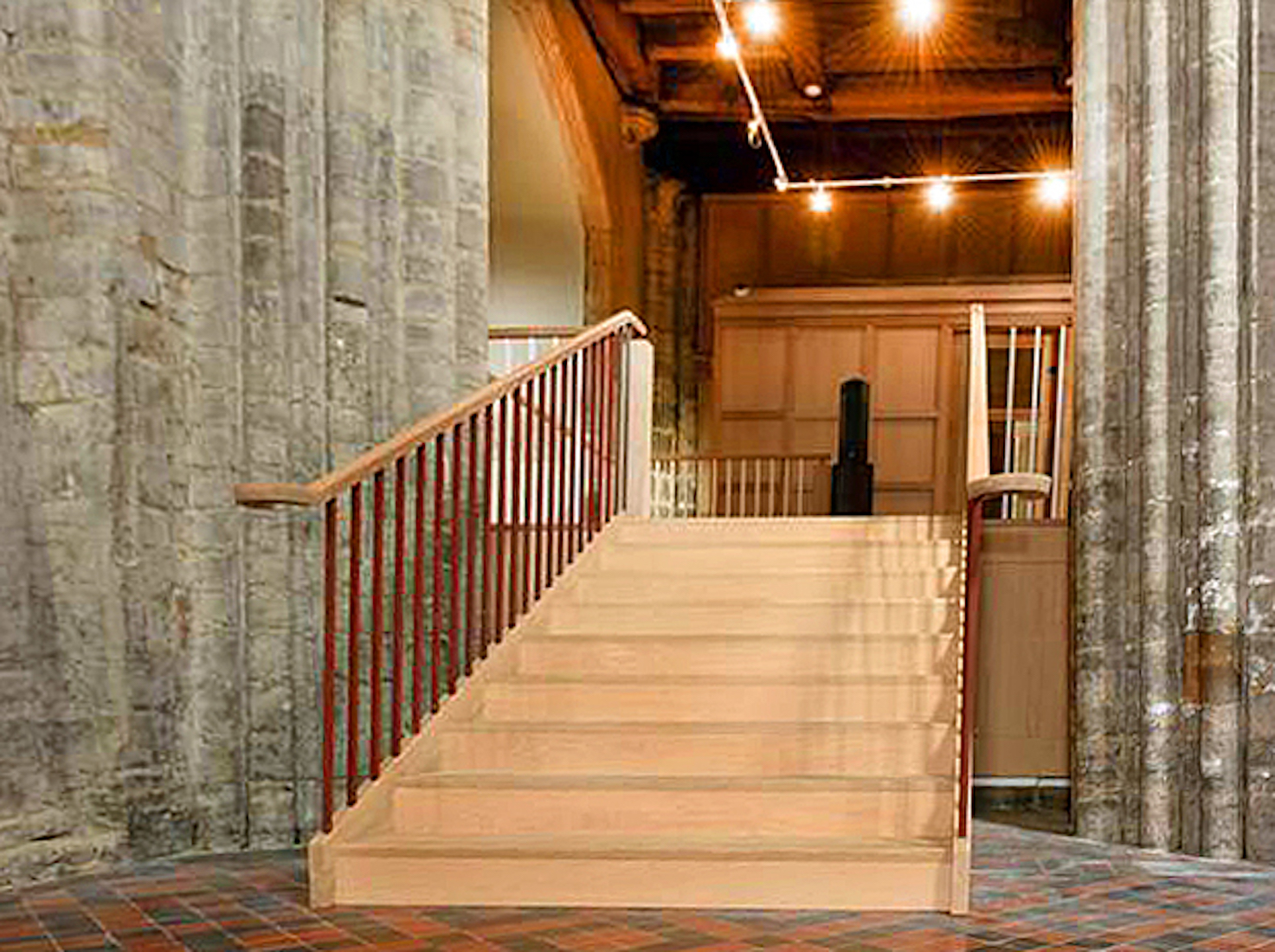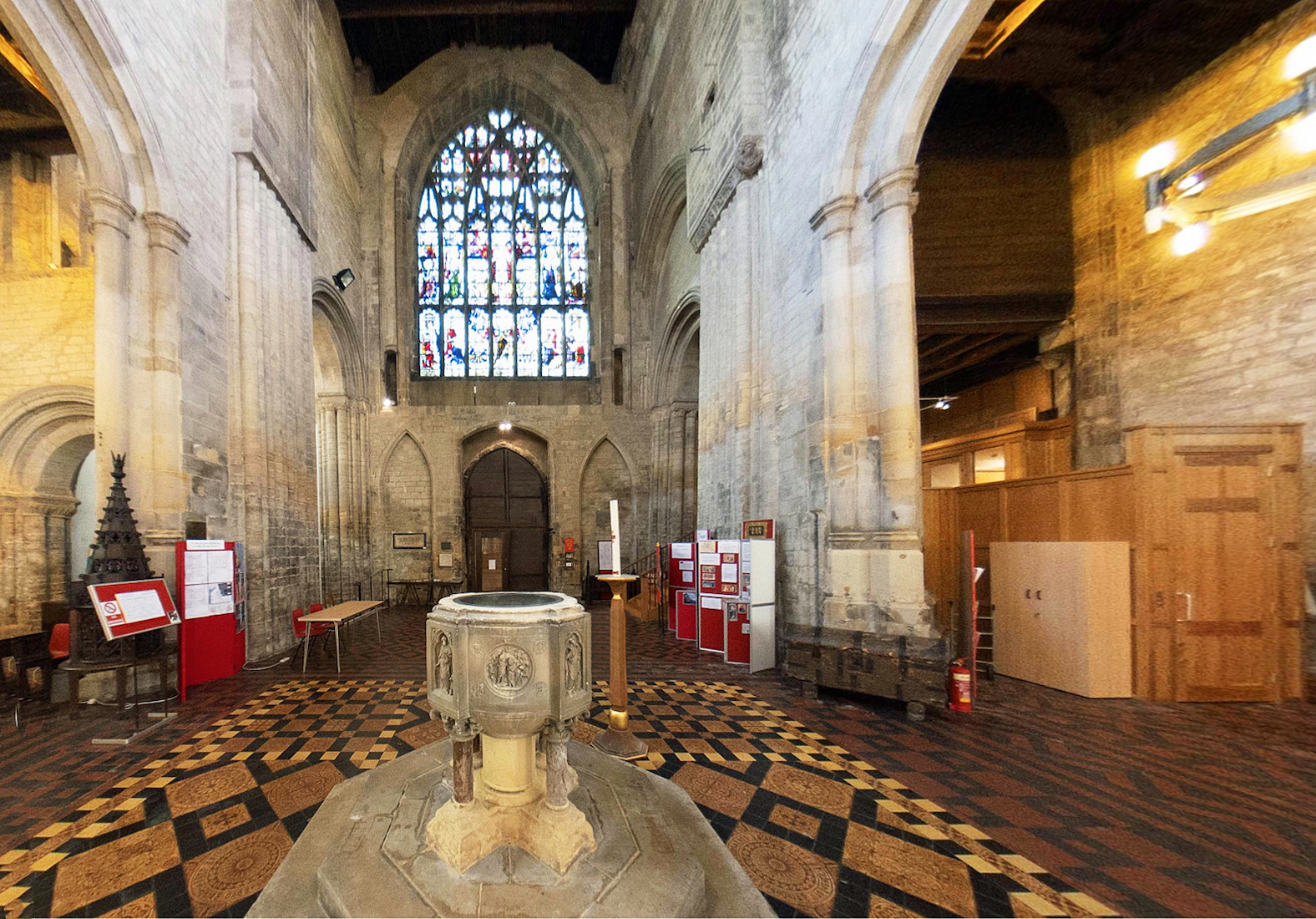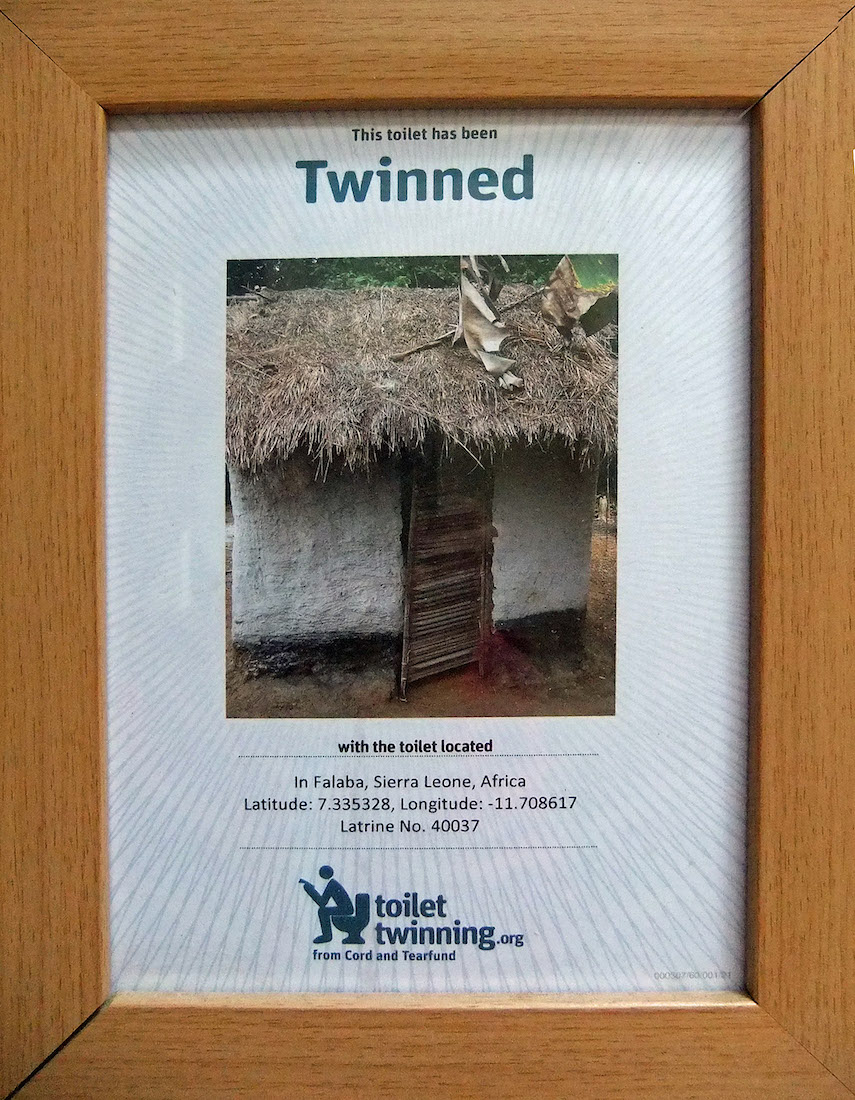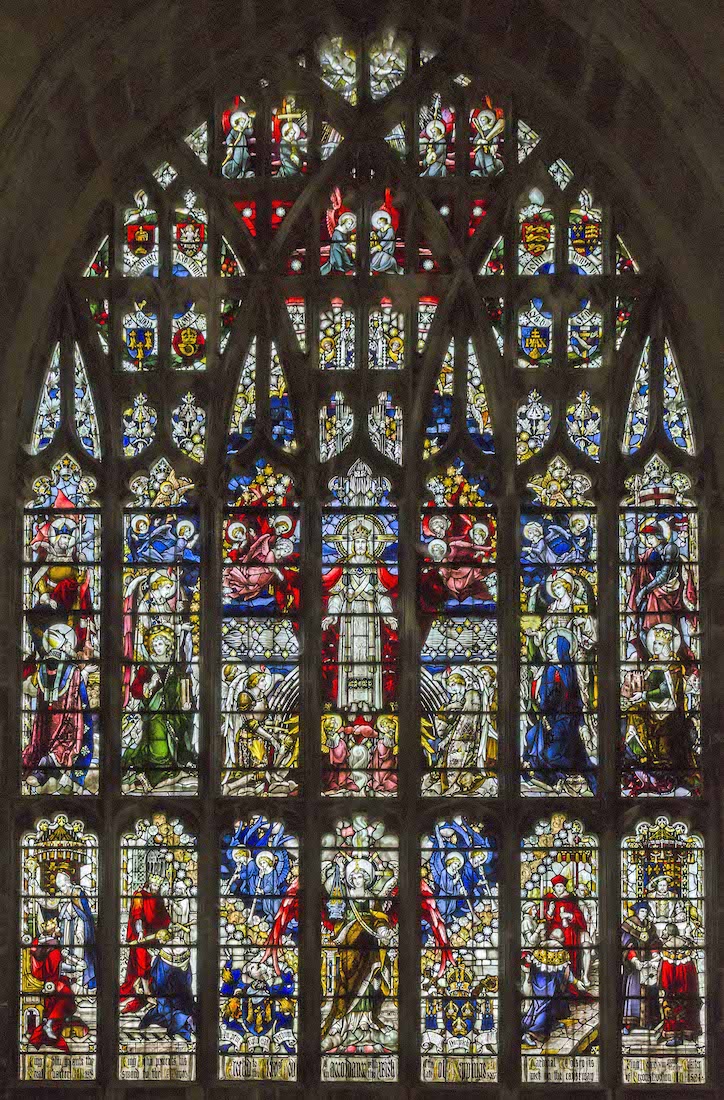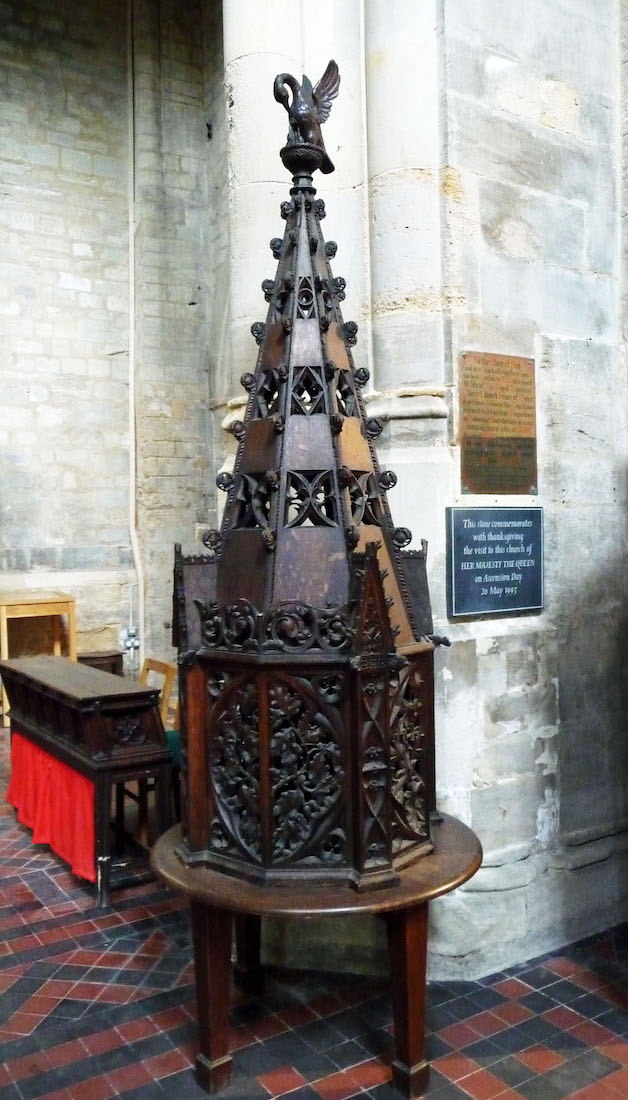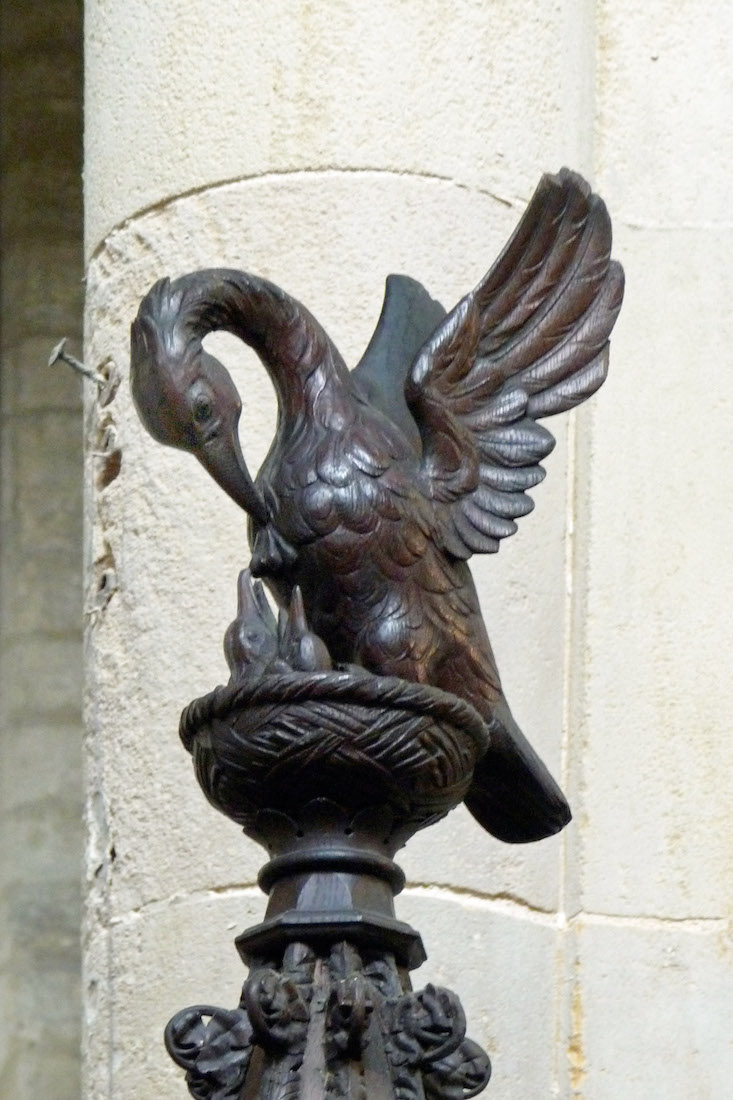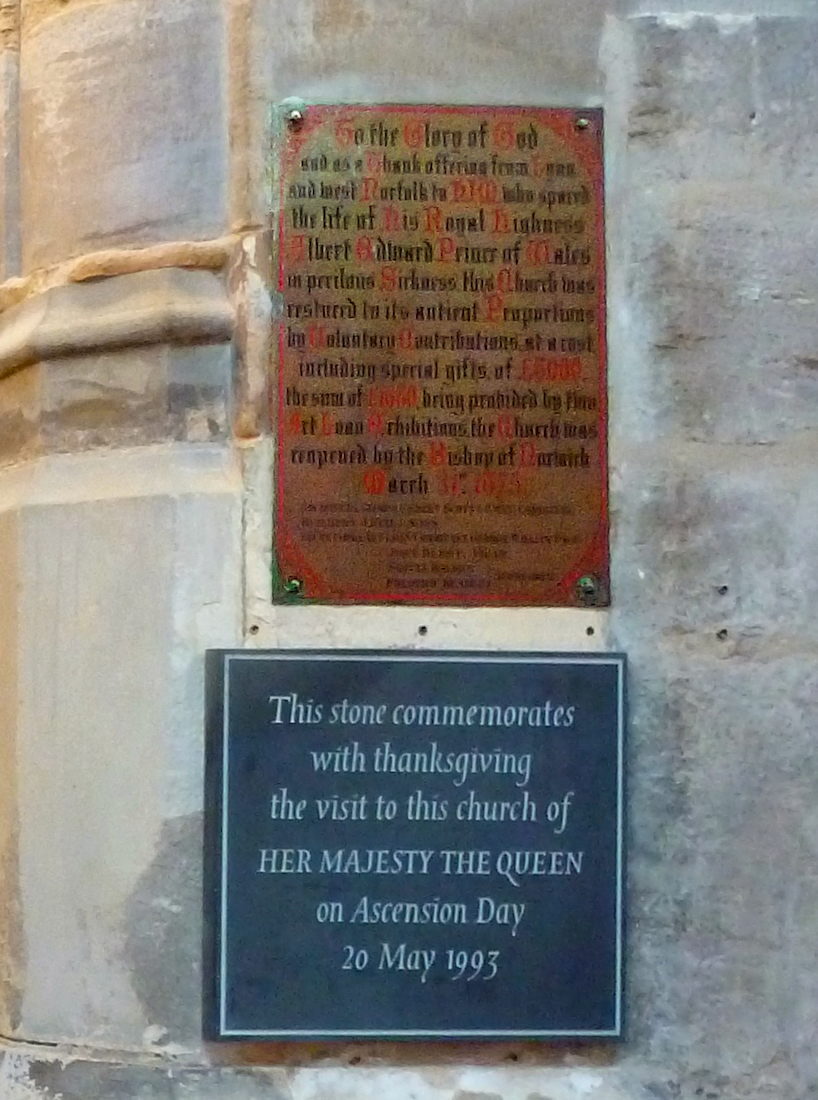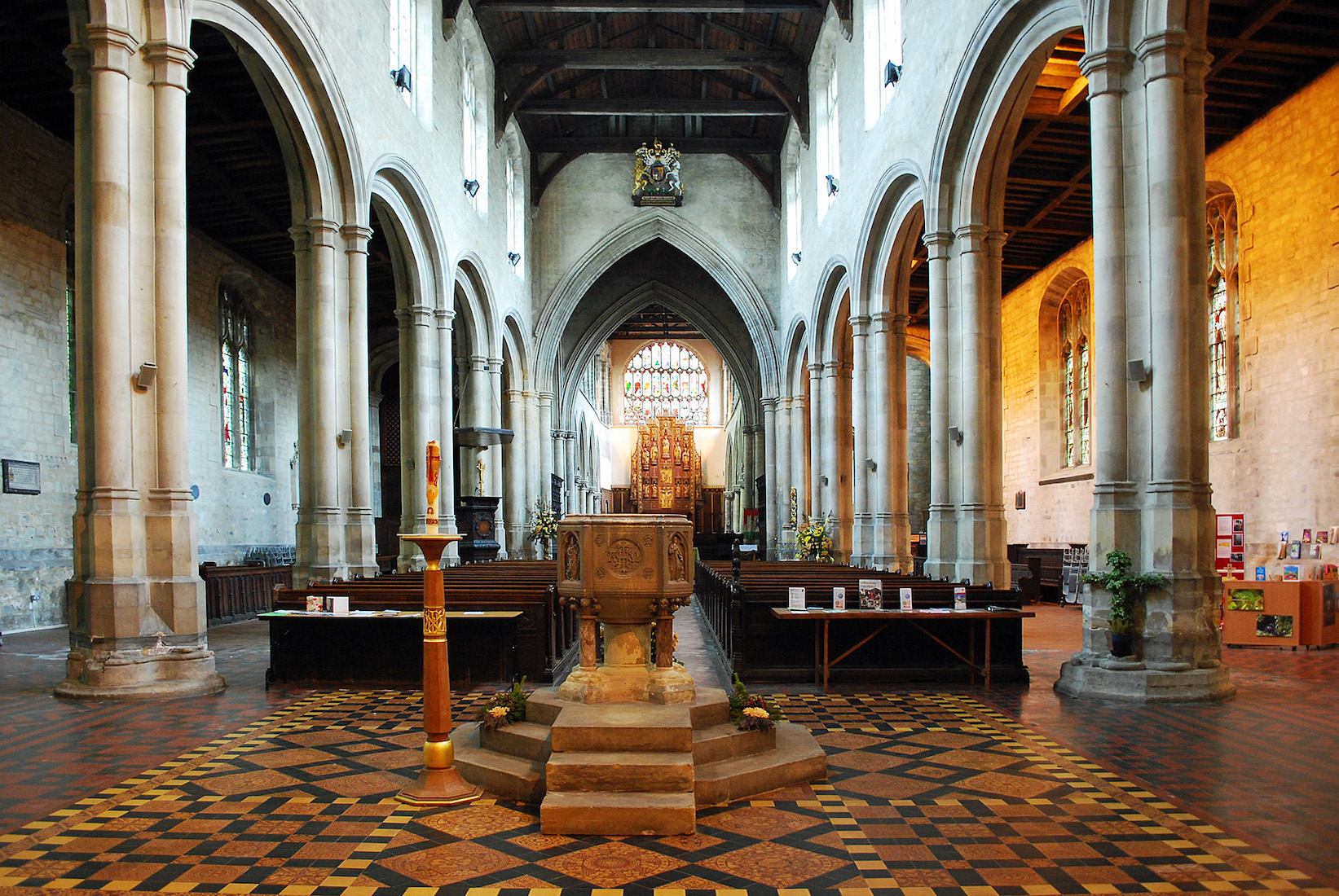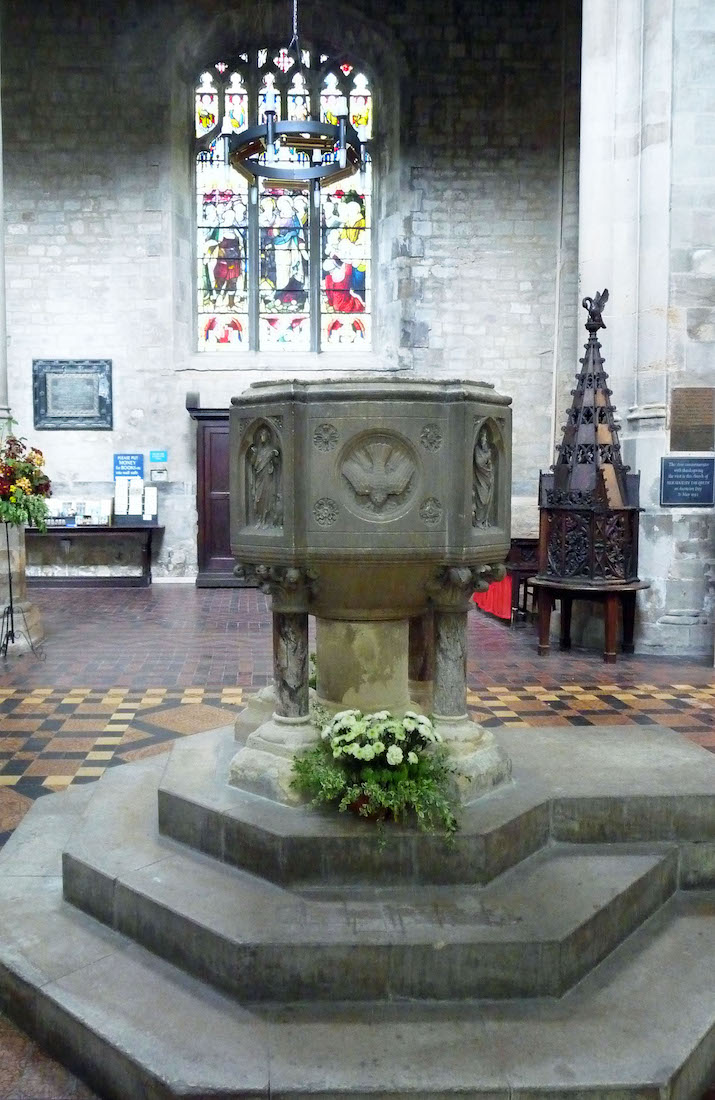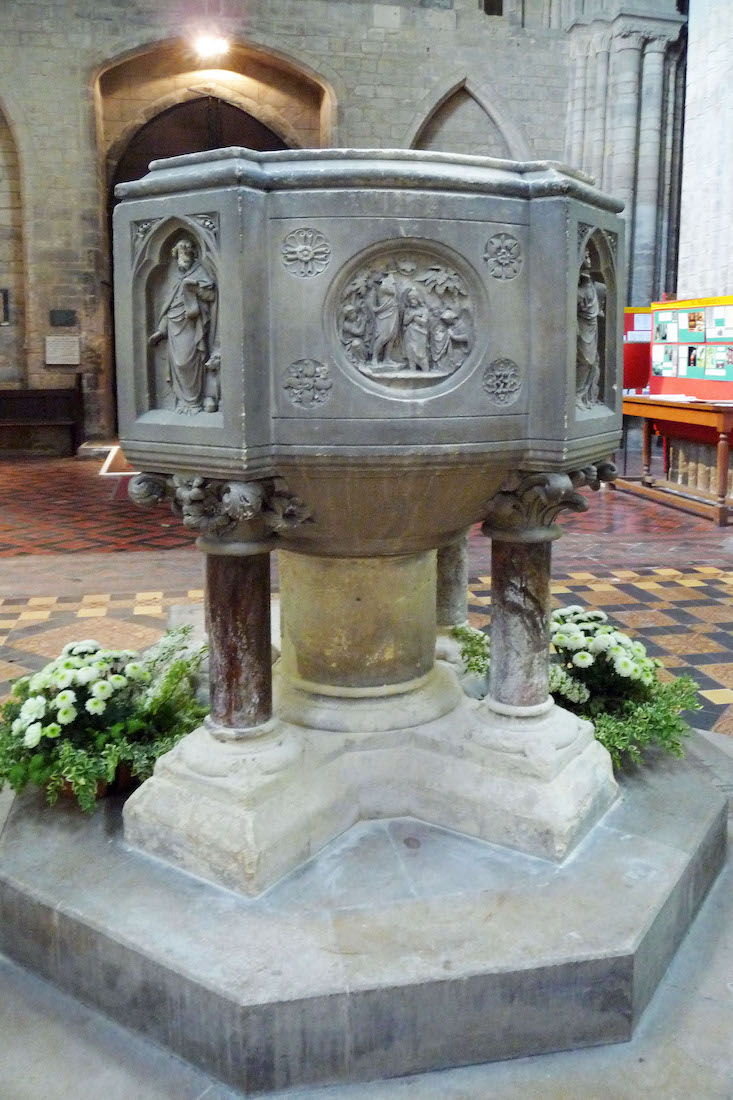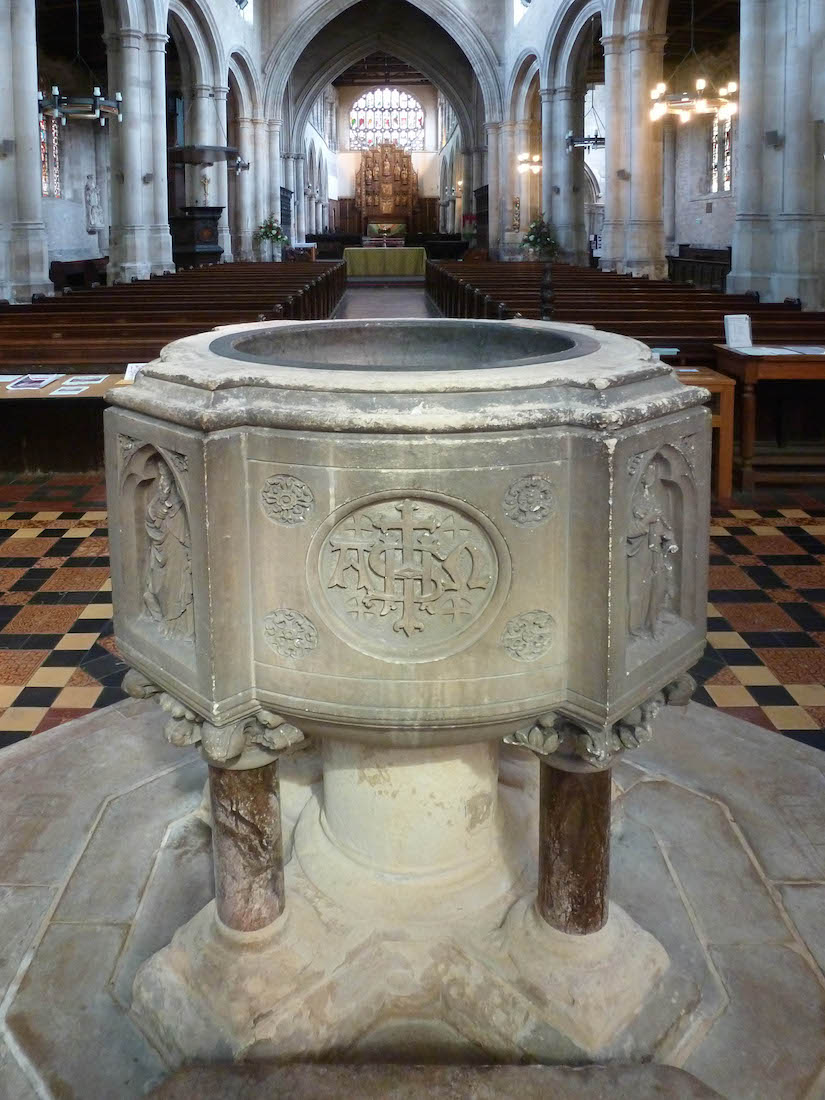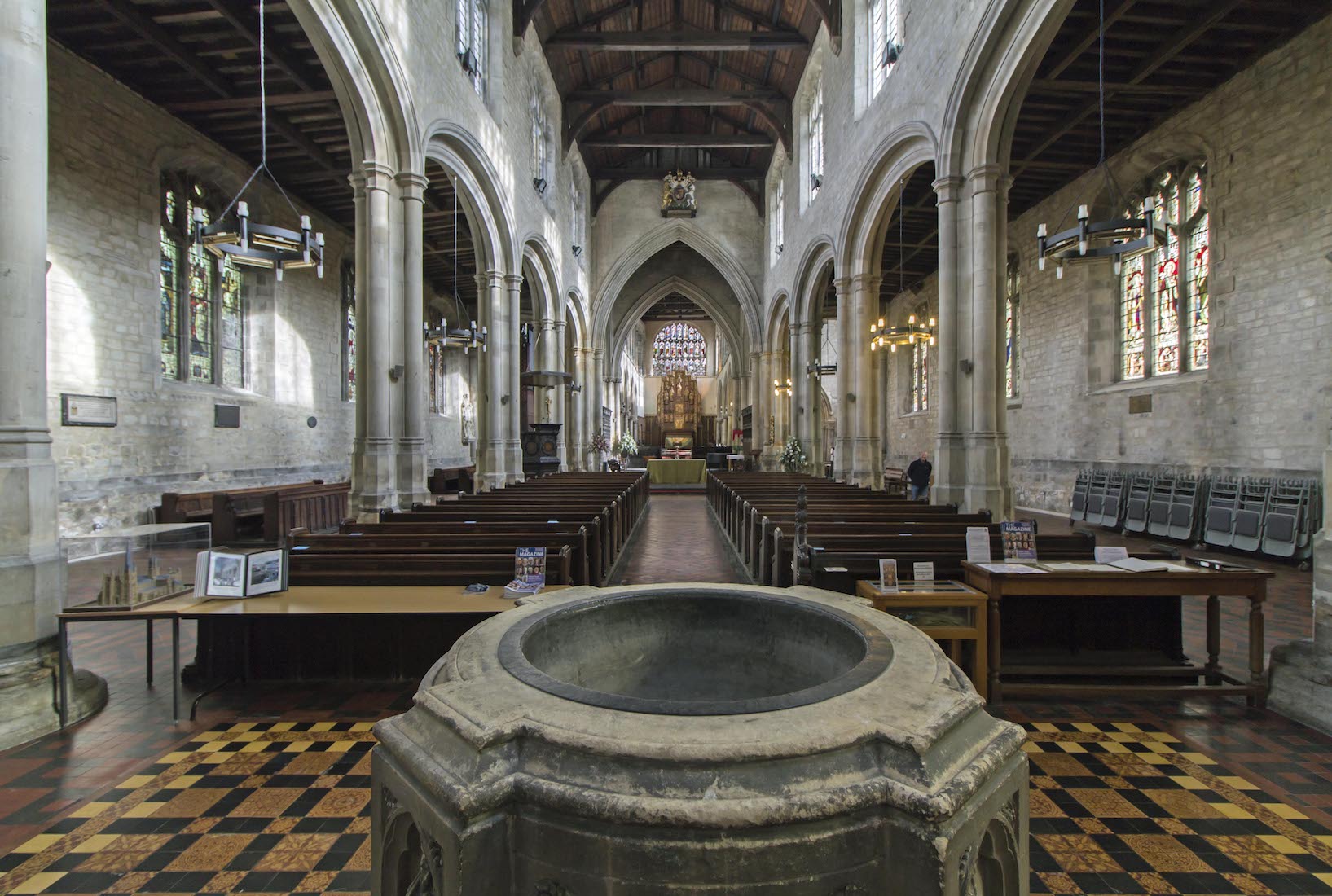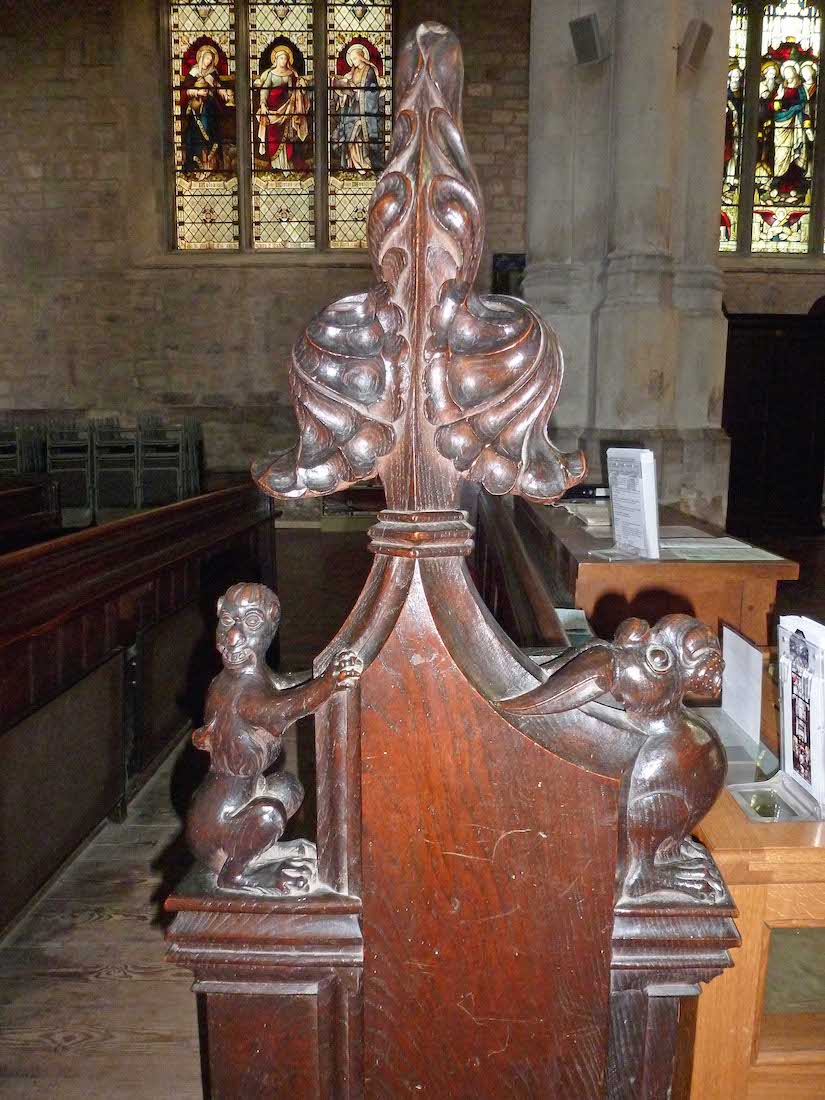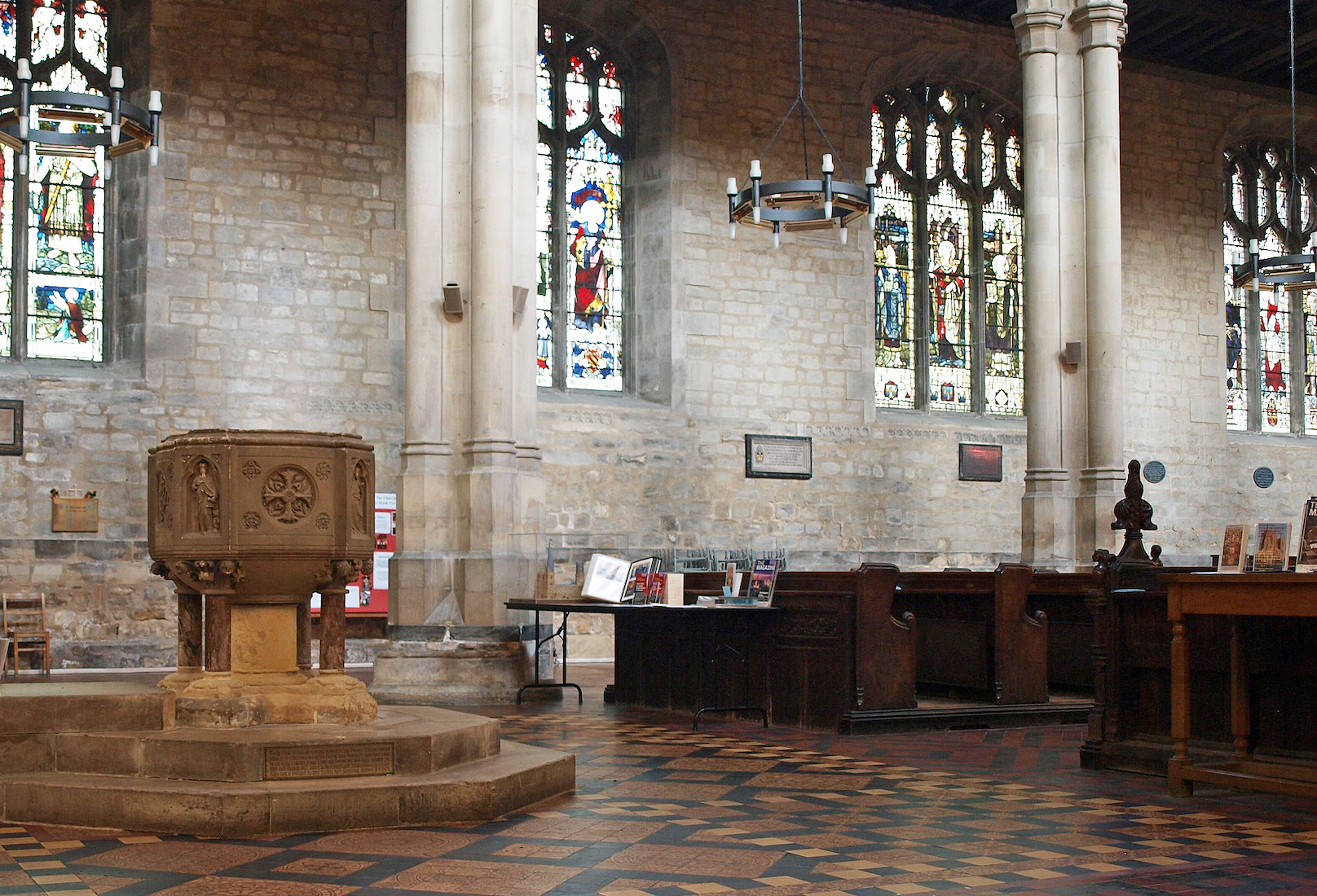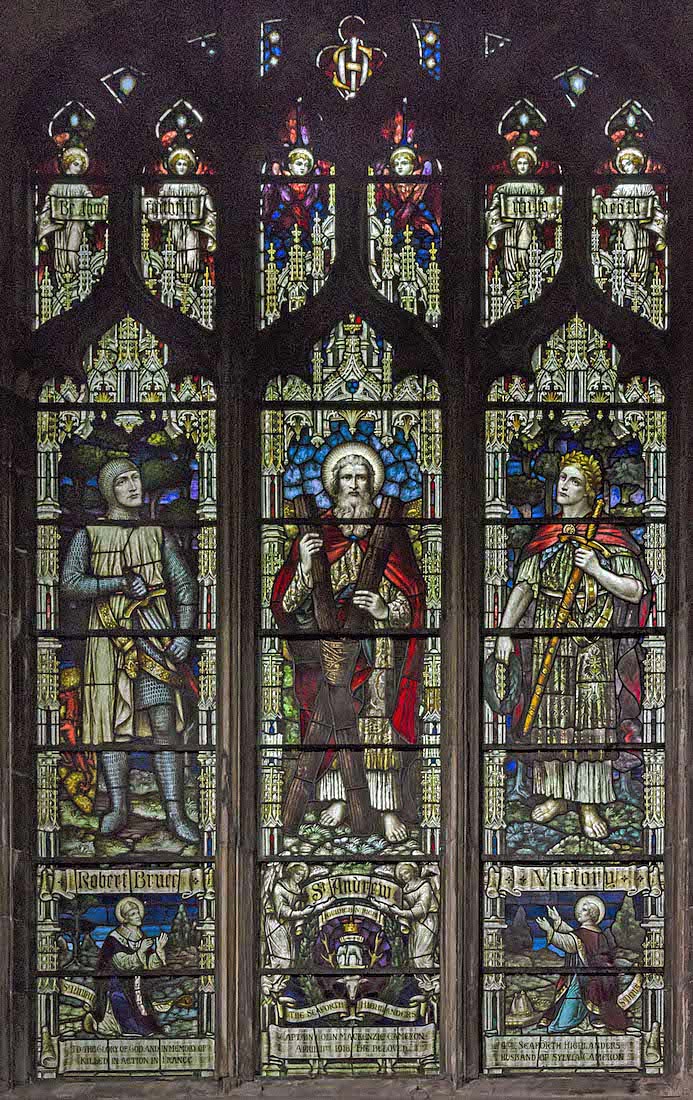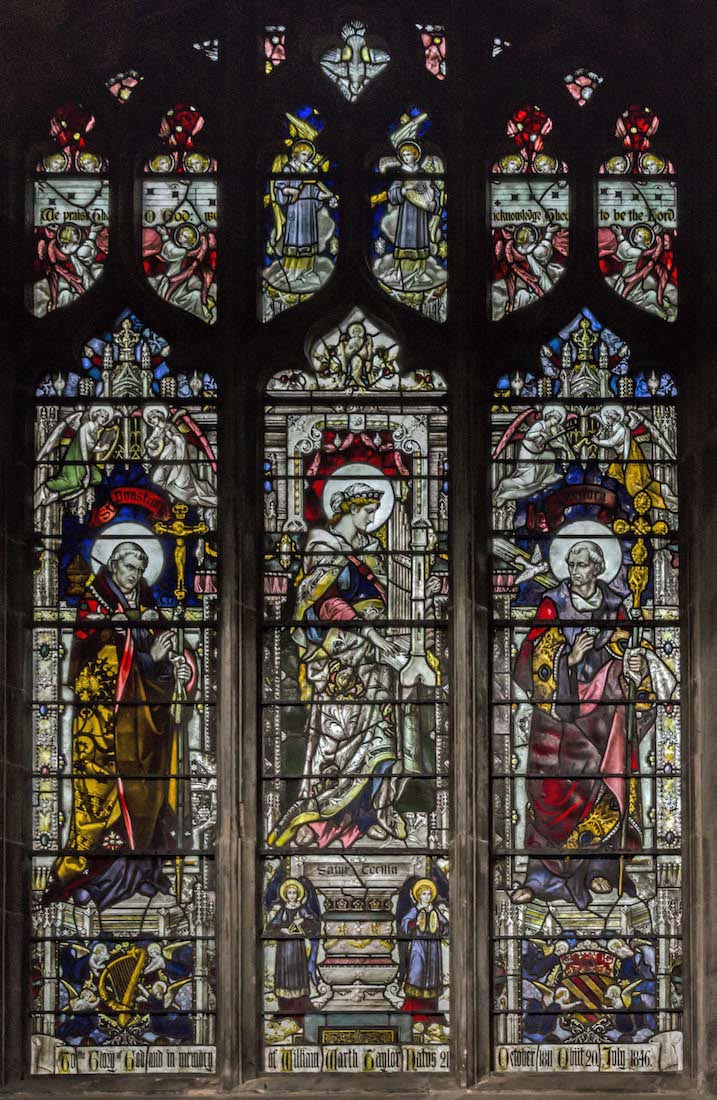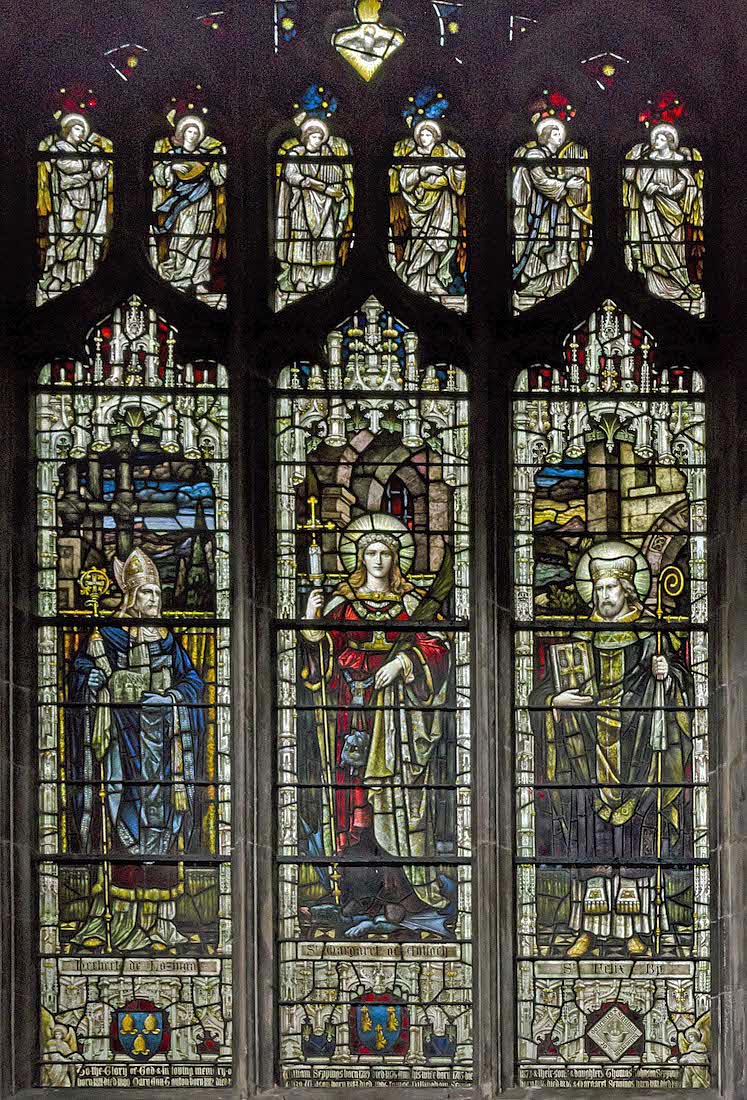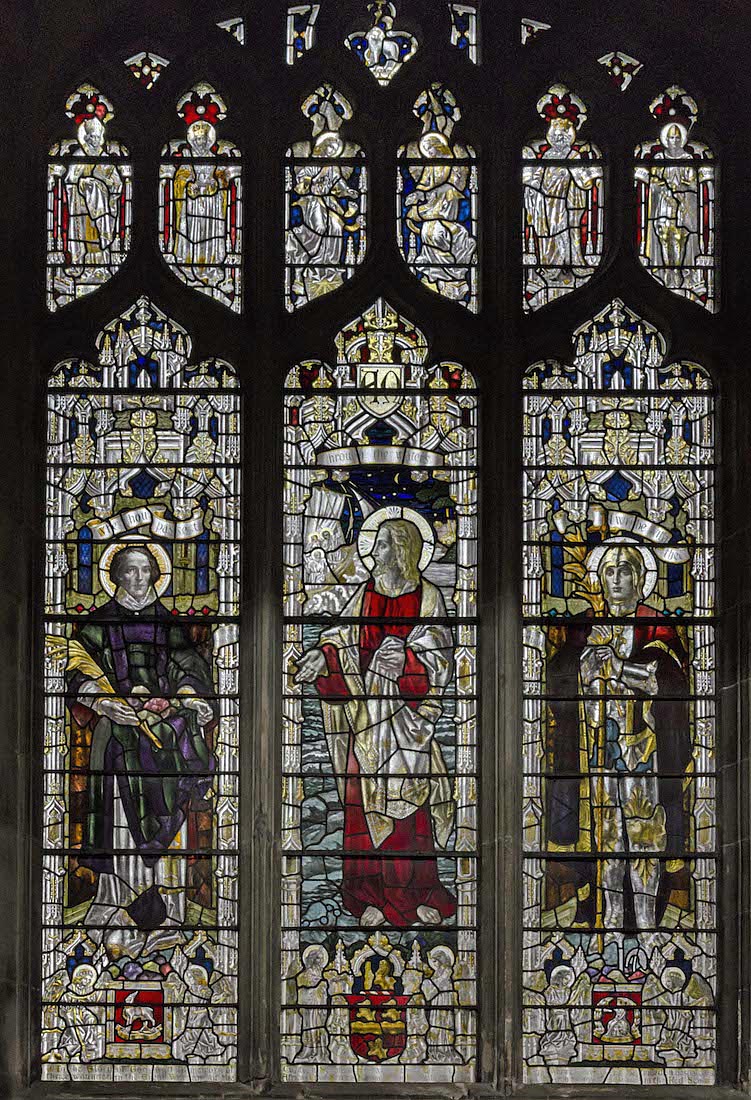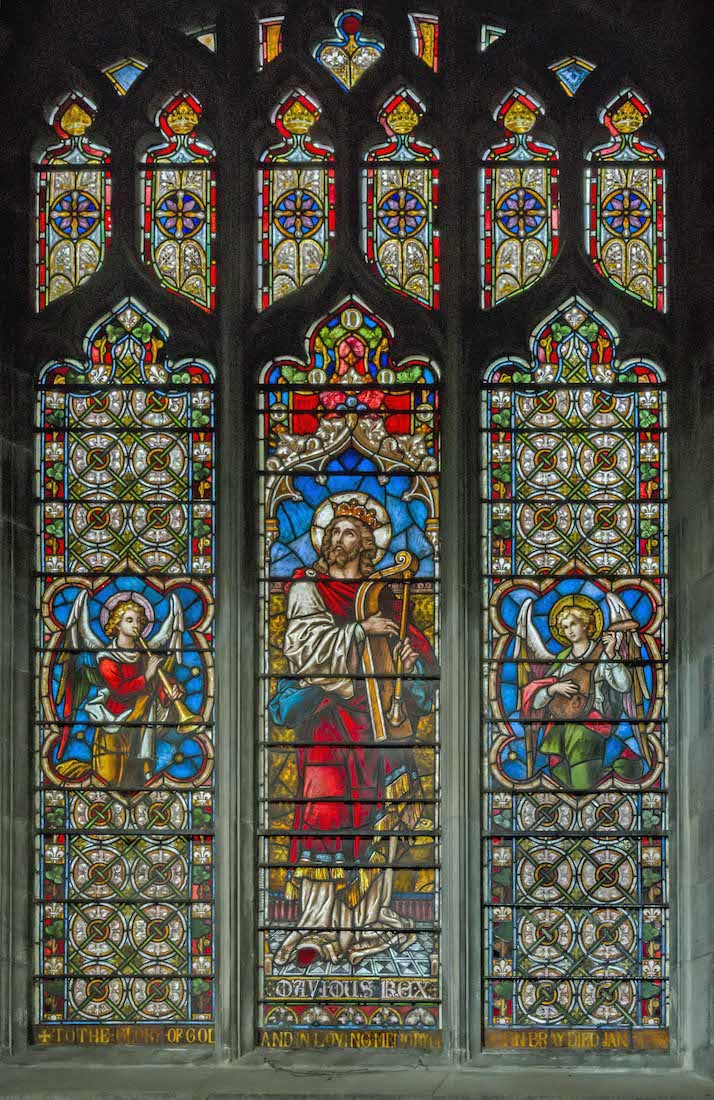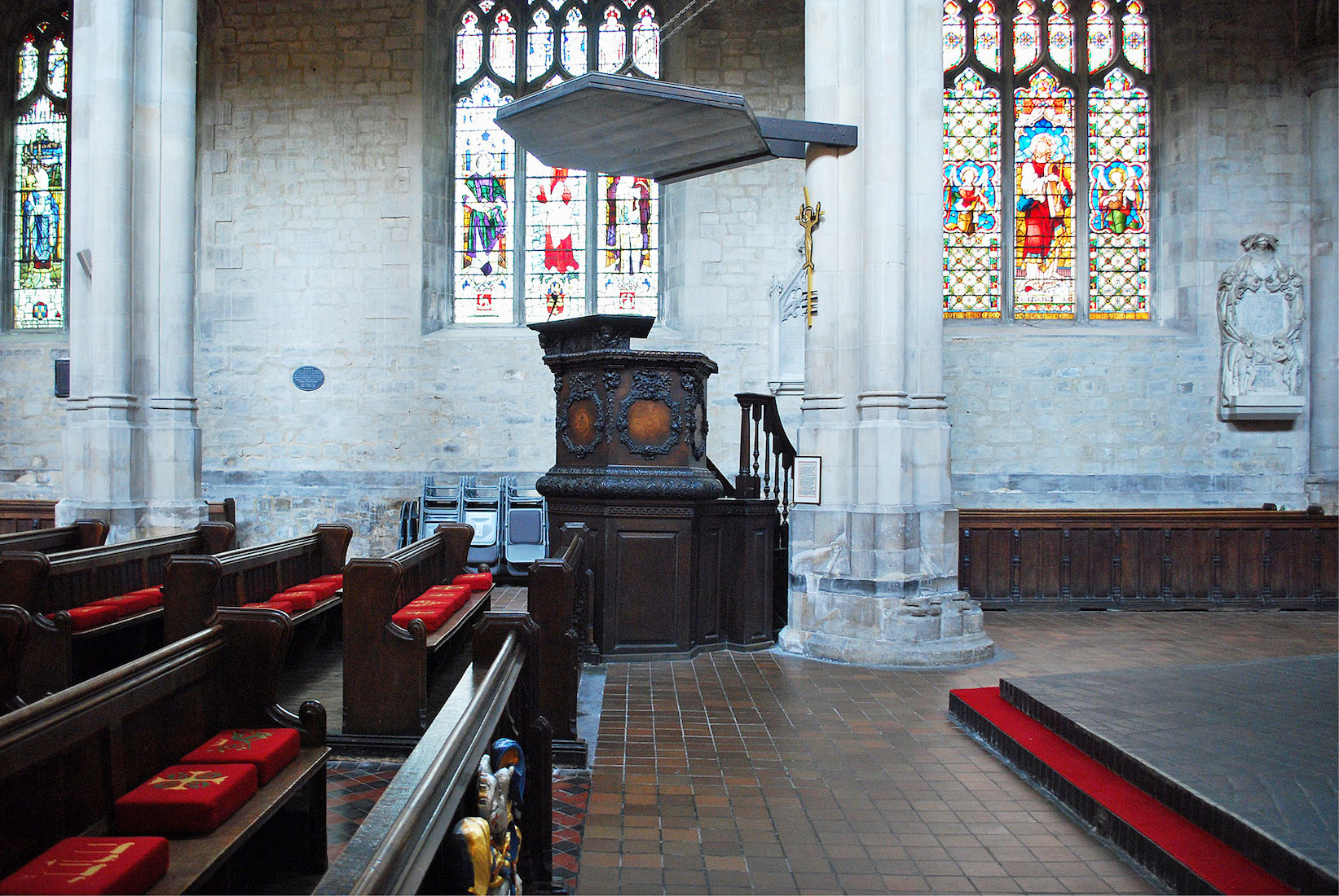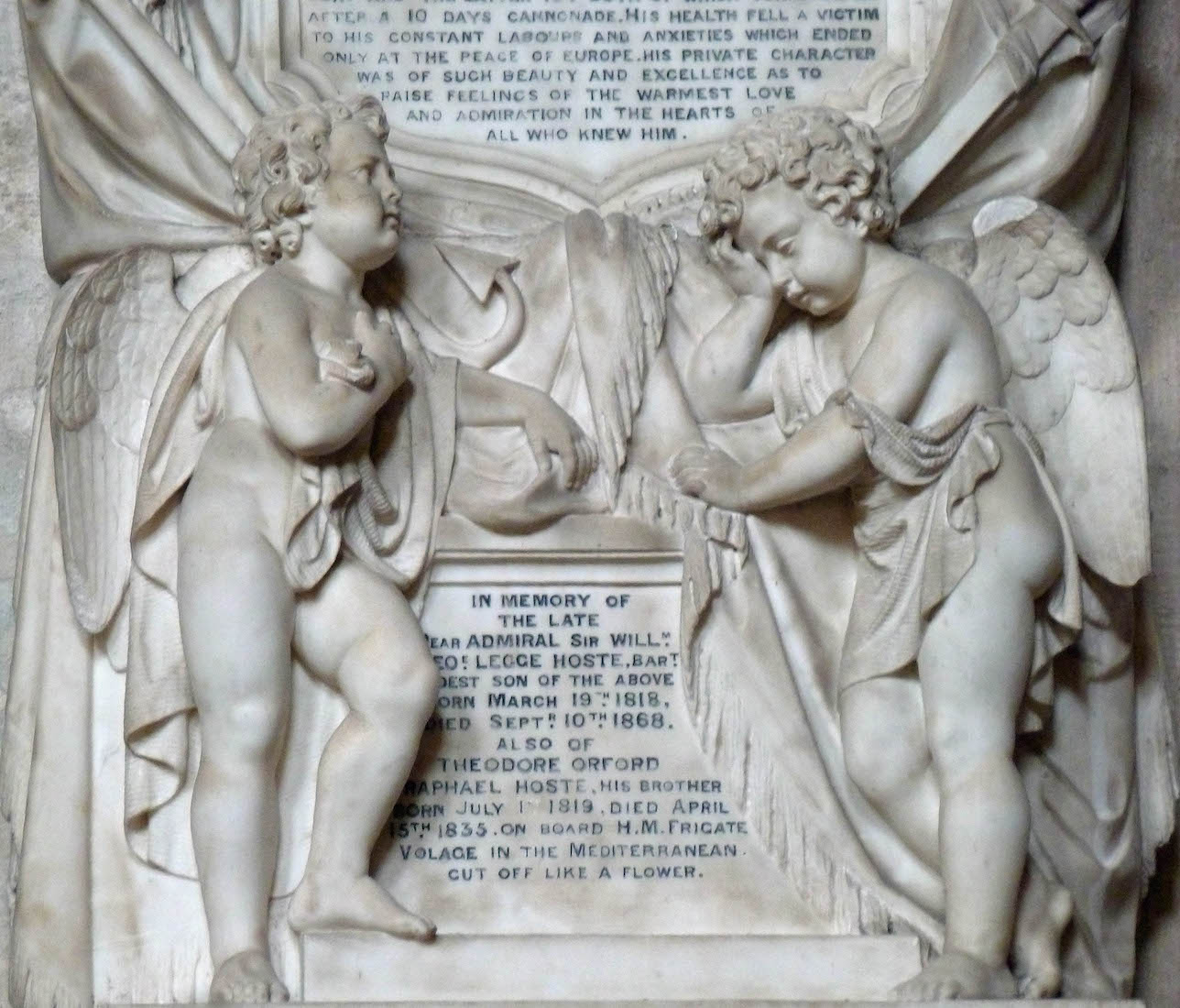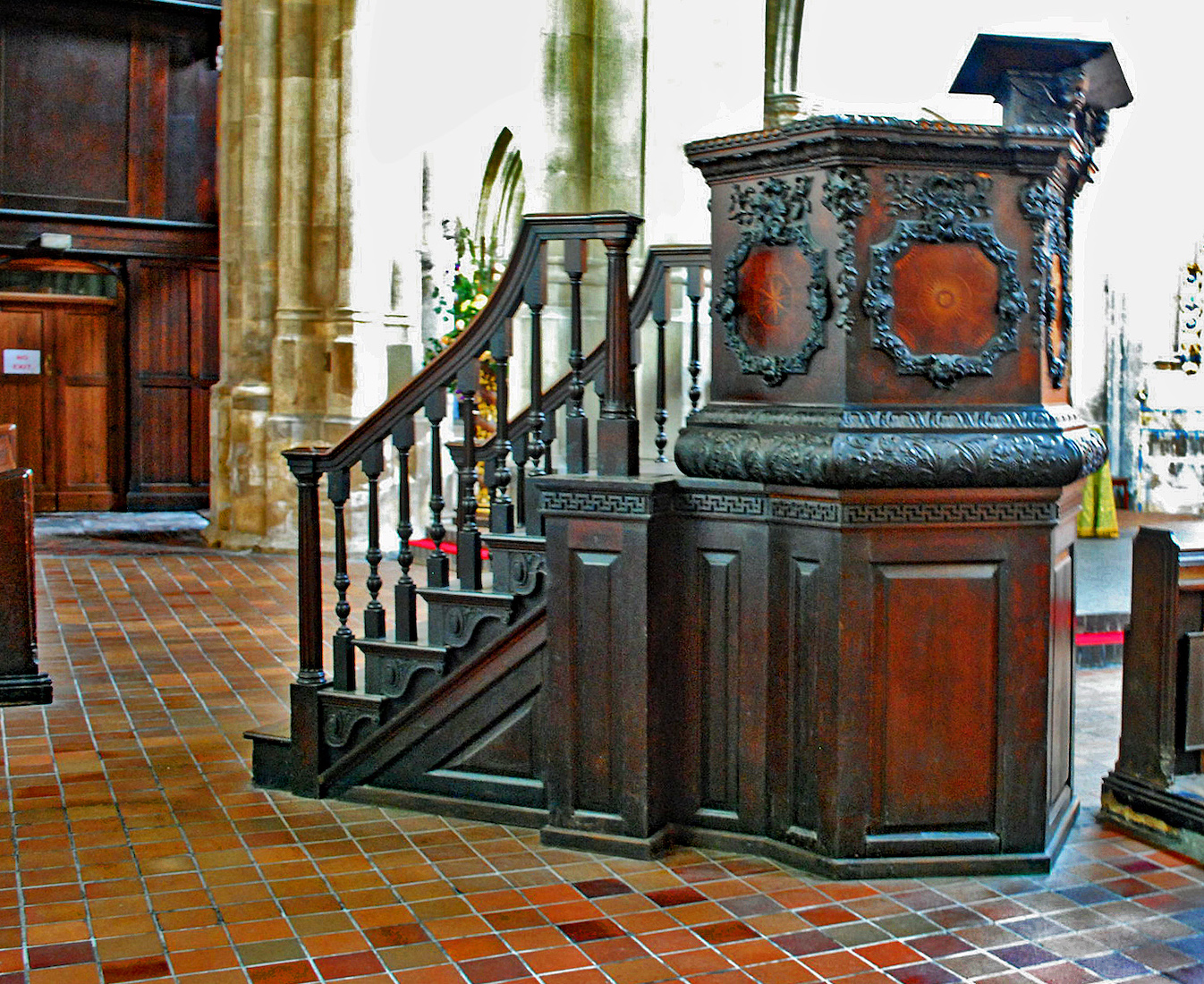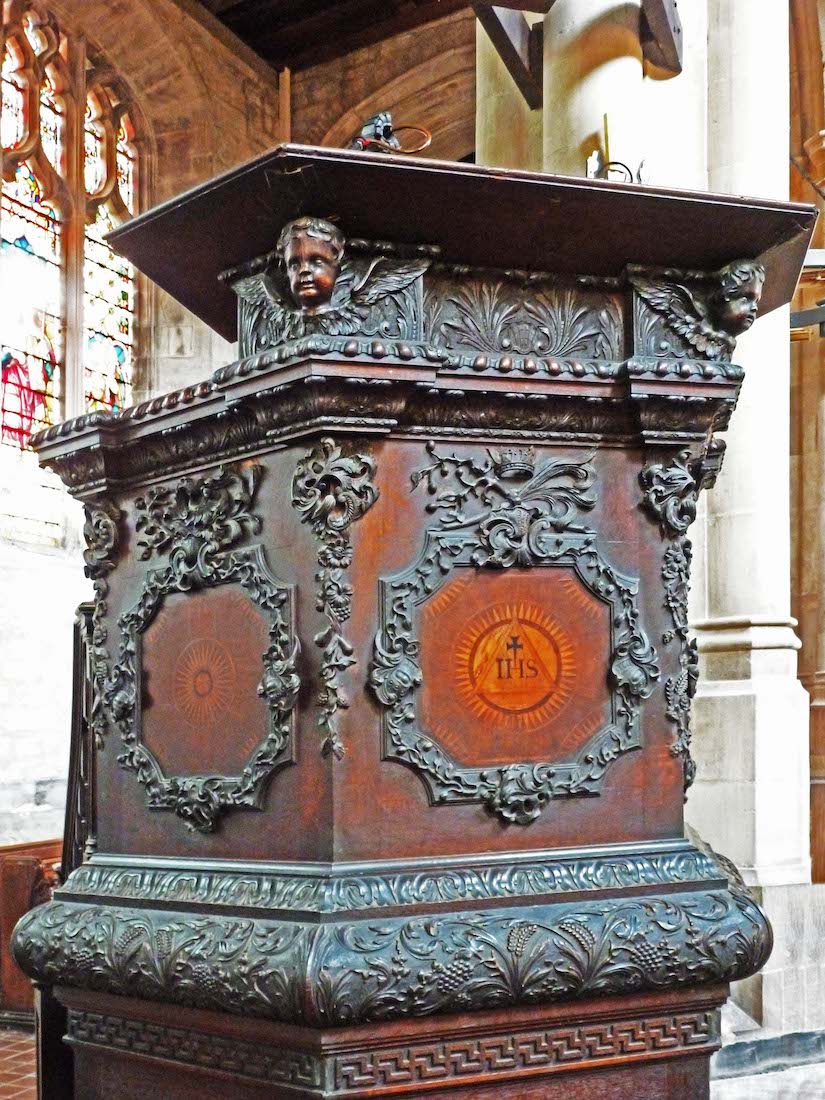21. SOME BRIGHT DECORATION GA J&J
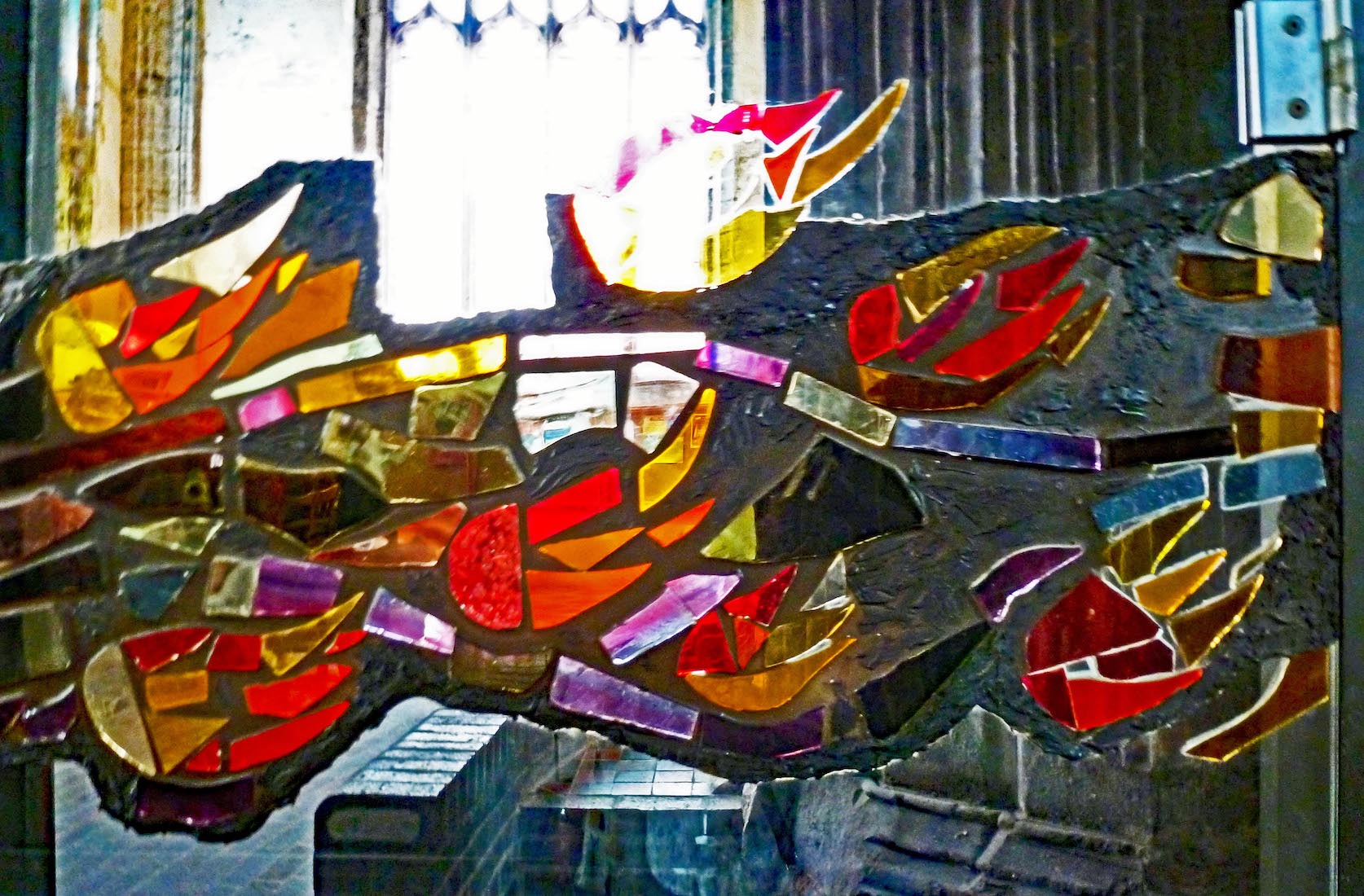
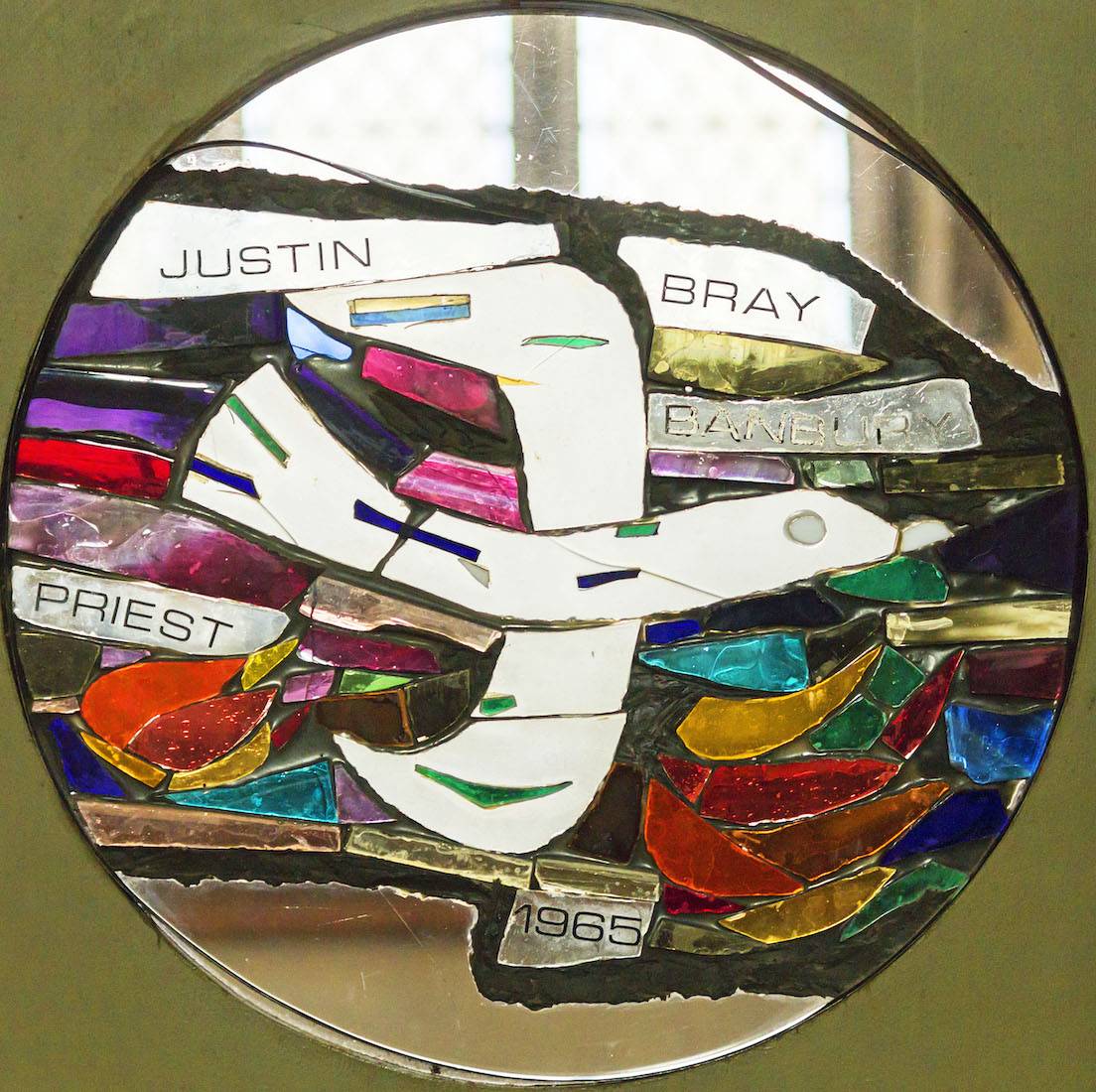
A close-up of the bright decoration in the doors screening off the North Porch. The roundel below is in memory of Rev Justin Banbury who died in 1965. As part of the recent renovations, the roundel has been placed in the North window of the Porch. INDEX
22. COXON WEST WINDOW J&J JJM GA
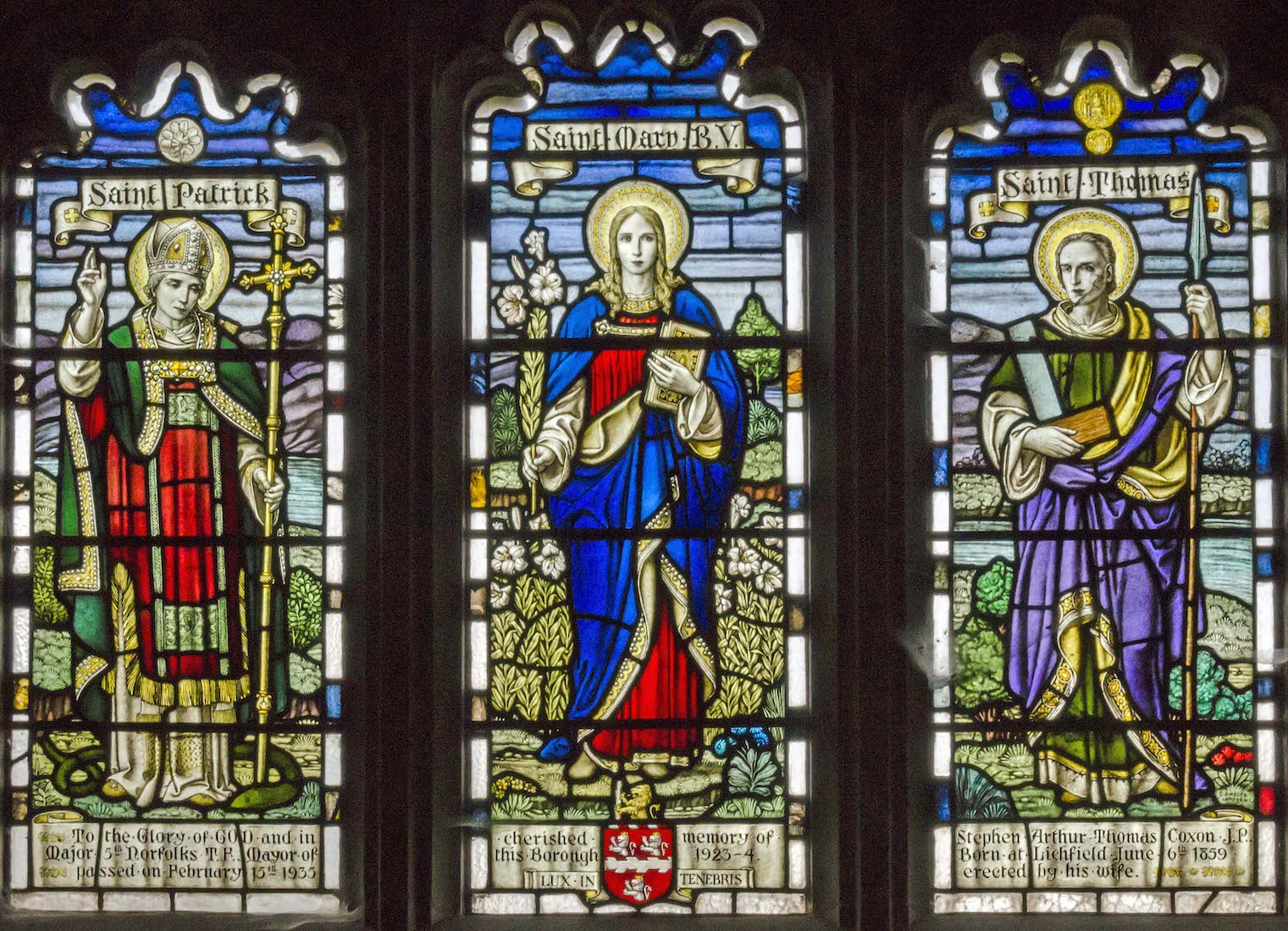
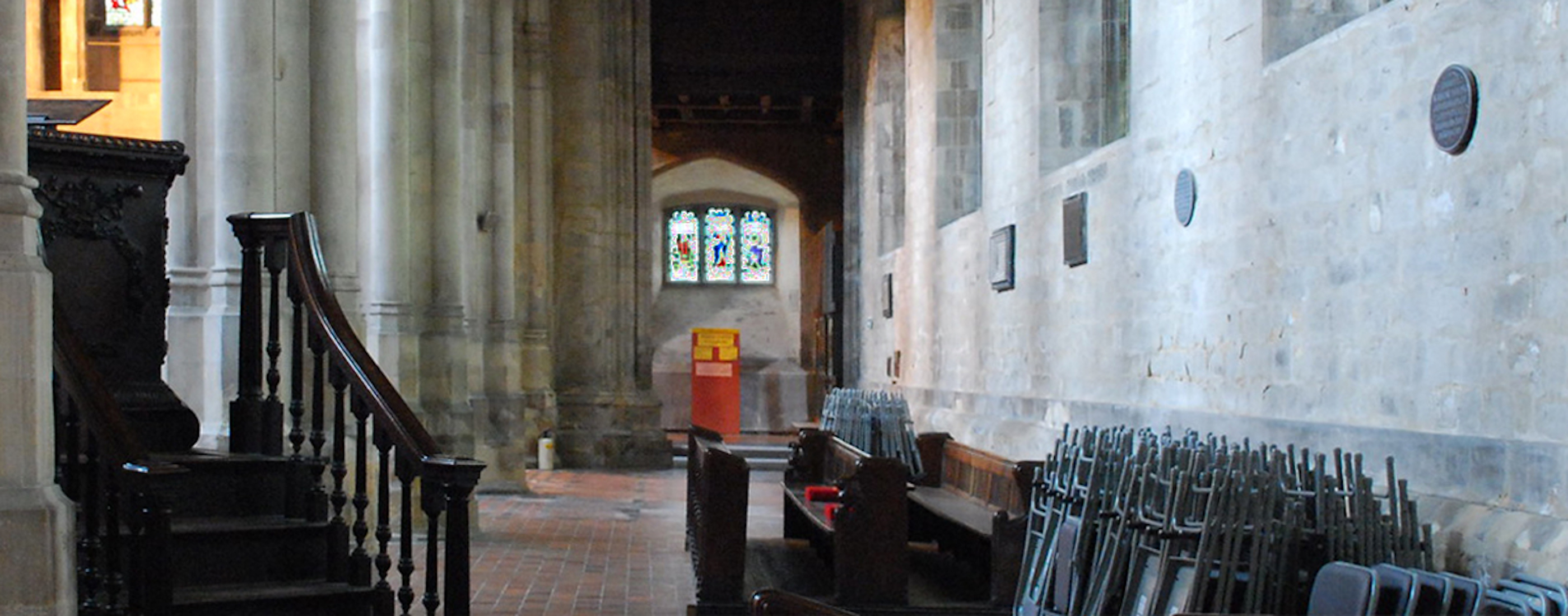
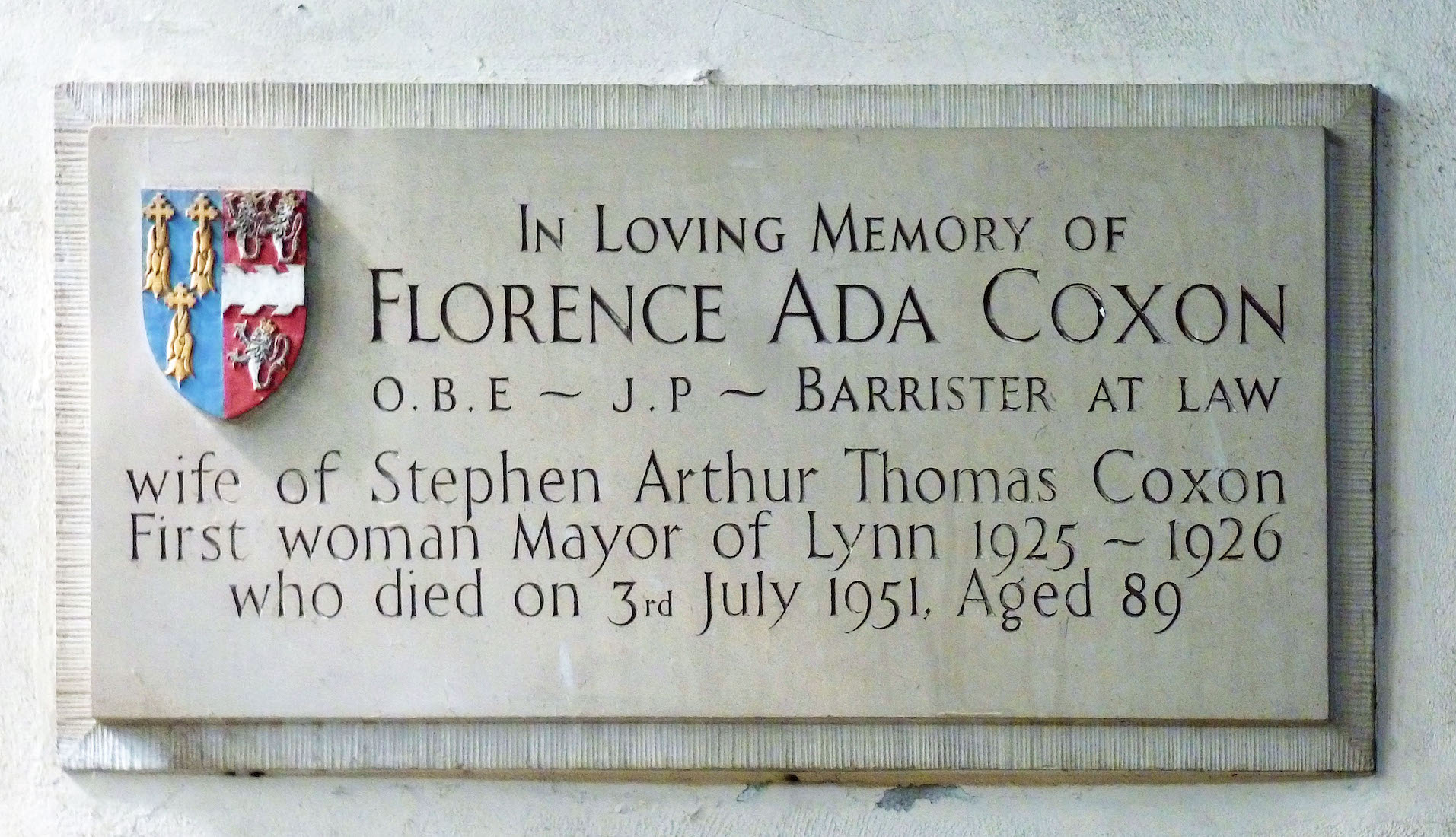
The old historic photo at bottom left shows that this window is placed at the West end of the North aisle. The window shows the Virgin Mary with St Patrick (with snake underfoot) and St Thomas. The window is by C. E. Moore,and was erected by Florence Ada Coxon. The window inscription says: ‘To the Glory of God and in cherished memory of Stephen Arthur Thomas Coxon JP, Major 5th Norfolks TF, Mayor of this Borough 1923-4. Born at Lichfield June 6th 1859, passed on February 15th 1935, erected by his wife.’ A separate plaque remembers Florence Ada Coxon.
23. NORTH PORCH WINDOW J&J
This large window in the West wall of the North Porch was created by Geoffrey Clarke in 1967. It is in memory of members of the Ayre Family who worshipped and worked in the Church for nearly 100 years.
24. NEW PORCH ACCESS KLM
From 2019 the view from the entry to the reconstructed North porch looks like this. The improvements include a new office, toilets and a meeting room.
25. NAVE WEST VIEW KLM
If we move into the nave and look back, we can see the effect of the North porch improvements at right. The modernisation will be much appreciated by those who work here, but there has been a loss of visual integrity to the old Minster. We also notice here the old font and Paschal candle with the surround of special tiling, the carved spire at left, and the West window beyond.
26. TWINNED TOILETS PRS
The Minster has had a long association with the Toilet Twinning project – a project providing basic toilets and access to clean water in poor communities around the world.
27. WEST WINDOW J&J
The West window of the Minster was installed in 1927 and was given by Colonel Thomas J Seppings who died in 1925. The glass was designed by Donald Taunton of John Hardman & Co. The stonework dates from the 15th century, the original glass was lost when the nave was destroyed by the spire of the Southwest tower falling in 1741. After this, the window was blocked and not re-opened until the mid-1860s. The organ was originally on a gallery in front of the West window. •• The subject of the window is a mixture of associated Saints and Kings with several Guilds and Bishops in the traceries. There are seven lights with upper and lower panels. At centre is Christ in Glory surrounded by Angels and Saints relating to the churches of King’s Lynn. The left-hand light contains St Edmund and St Nicolas with King John granting the town its Charter at the bottom. The next light depicts St John the Evangelist, and King John presenting his sword to the Mayor in the panel below. On the right-hand side of the window we see the Virgin Mary, St George, St Margaret and finally Henry VIII and Cardinal Wolsey.
28. FONT COVER GA GA
Close to the West door we find the font cover – a carved spire and tower, perhaps in memory of the long lost real spires. At the top of this spire there is a pelican feeding her chicks with blood drawn from her breast – an old Christian illustration of the the freely shed blood of Christ.
29. MEMORIALS GA
On the wall close to the spire are two memorials. One commemorates the visit of Her Majesty the Queen to this Church in 1993. The other is a note of Thanksgiving to God for the recovery of His Royal Highness Albert Edward, Prince of Wales from a perilous sickness.
30. FONT AND NAVE JJM
We are now standing close to the font which is used for baptisms. The baptismal font is often placed near to the entrance to a Church, as the rite of Christian baptism is symbolic of entering into the fellowship of the Church as well as into the life with Christ. Notice the Paschal candle standing close by, a reminder that Christ is the Light of the World.
31. FONT GA GA GA
The 19th century carved font looks imposing on its raised pedestal. The font cover is in the background. The eight sides include carvings of figures of the Four Evangelists, the dove which symbolises the Holy Spirit, and a scene from the baptism of Christ. The font’s carved top is stored separately.
32. NAVE J&J
From the font we can look towards the sanctuary and observe the details of the nave. Just in front of us, on the right, is a ‘poppyhead’ on the end of the pew. And at the top of the chancel arch is a Royal Insignia. The pulpit looks interesting, and we will want to investigate the stained glass windows!
33. PEW POPPYHEAD GA J&J
It is not uncommon to find a carved ‘poppyhead’ like this in these old churches, but it is perhaps more uncommon to find just one!
34. ROYAL COAT OF ARMS GA
The soaring chancel arch is surmounted by a Charles II (reigned 1660 – 1685) royal arms. These contain a crowned lion (left), a symbol of England, and a unicorn (right), a symbol of Scotland. (Wales had no national status at the time.) The crest (center) represents England, Scotland and Ireland: the three lions of England appear in the first and third quadrant, the lion of Scotland in the second, and the harp of Ireland in the fourth. The three fleurs-de-lis in the first and third quadrants signal an old claim to the French throne. The motto on the garter surrounding the crest reads: “Honi soit qui mal y pense” (‘Evil to him who evil thinks’). Charles II’s motto, “Dieu et mon droit,” (‘God and my right’) stretches across the bottom. A lower inscription remembers the names of the church wardens ‘Mathias T Welles & Thomas Thetford Church Wardens 1660.’
35. TO THE NORTH WALL SB
From the font we move across to the North aisle to investigate the stained glass windows. There is little else on this wall apart from the occasional small plaque. [Photo Credit: Simon Barnett]
36. NORTH NAVE WINDOWS I J&J J&J J&J
We look at the windows in the North aisle, starting from the Western end. They show: • St Andrew with Robert the Bruce and Victory; • St Cecilia with St Dunstan on the left and St Gregory on the right (the ‘Music Window’, 1927). Given in memory of William Taylor who died in 1846; • Bishop Herbert de Losinga, St Margaret with the vanquished dragon, and St Felix, First Bishop of East Anglia c 630 AD. The window was given in memory of the Seppings family.
37. NORTH NAVE WINDOWS II J&J J&J
Continuing with the North aisle windows, from left: • Christ walking on water with St Stephen and St Alban. In memory of Stephen H. N. Coxon, d.1923. The window was installed in 1927. • A musical window featuring King David and his harp, and angels with musical instruments. Glass by Mayer & Co in memory of John Bray, a local musician, who died in 1883.
38. PULPIT AND BEYOND JJM
Following along these windows brings us to the Georgian pulpit with its large ‘tester’ or sound board. On the North wall, just East of the last window is a memorial to Sir William Hoste. Notice too the metal cross on the column behind the pulpit, and the explanatory sheet below. We shall return to this.
39. HOSTE MEMORIAL GA GA
Among the most interesting memorials is a wall monument to Sir William Hoste (1780 – 1828), a naval officer who served with Admiral Nelson at the Battle of the Nile. Best known as one of Lord Nelson’s protégés, Hoste was one of the great frigate captains of the Napoleonic wars, taking part in six major actions including the capture of the heavily fortified port of Kotor.
40. PULPIT JJM GA
After the terrible storm in 1741 caused the spire of the Southwest tower to collapse, the nave and aisles had to be rebuilt. Most of the Georgian furnishings were removed in the Victorian period under the direction of the famous church architect Sir George Gilbert Scott. The only Georgian features to remain are the richly carved pulpit with sounding board above.


